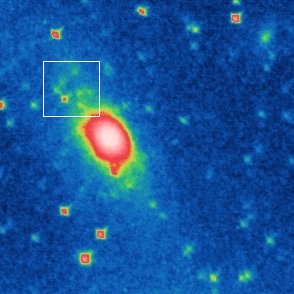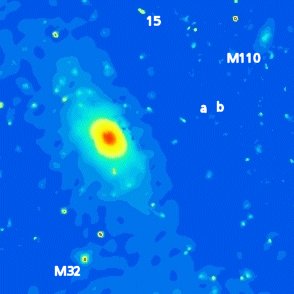Restoration of Digitized Astronomical Plates with the Pixon Method
presented at Astronomical Data Analysis Software & Systems XII Meeting, 13-16 Oktober 2002, Baltimore, Maryland USA
© Copyright 2003
Astronomical Society of the Pacific, 390 Ashton Av., San Francisco, CA
94112
Hiltner, P.R., Kroll, P.
Sonneberg Observatory
Sternwartestr. 32
D-96515 Sonneberg
Email: pk@stw.tu-ilmenau.de
Nestler, R., Franke, K.-H.
Technical University of Ilmenau, Faculty of Computer
Science and Automation, Computer Graphics Program
POB 100565
D-98684 Ilmenau
Email: rico.nestler@tu-ilmenau.de
Abstract: Applications of the Pixon Restoration Method to digitized plates of the Sonneberg Plate
Archive - the world's 2nd largest - are reported. Results so far obtained show that the
severe astigmatism/coma distortion present in the outer parts of the wide field images
can almost completely be removed. Also, object definition (FHWM) of point sources and
S/N improve by factors of 2 to 7, depending on the object strength and location,
background etc. We shortly address consequences for the inclusion of digitized archives
in the virtual observatory context.
Keywords: photographic plates, archives, sky patrol, virtual observatory,
image: restoration, pixon method
1 Introduction
Sonneberg Observatory in the Thuringian forest, blessed with a still scarcely light-polluted
night sky, is collecting photographic sky images of selected sky areas since about 1930, and
since the 1950's also of the whole northern sky, in a systematic fashion named "Sky Patrol".
The main purpose hitherto has been the detection and study of variable stars. In order to
transform the rich collection of astronomical plates to a form which is useful and accessible
to the astronomical community, digitization of the plates was begun several years ago.
Quite a lot of telescopes, cameras and photographic emulsions have been used over the years to
collect these data, each of them with its own peculiarities and shortcomings. In particular,
we are dealing with wide angle astrophotography which is without comparison in the era of CCDs:
about 4.3deg field size for the Schmidt plates, 11deg for astrograph plates, and 27deg
for the Sky Patrol plates. The latter, on which we shall concentrate here, suffer from severe
astigmatism affecting more than 75% of the plate area. Thus it is obvious that the
digitization process should include steps beyond the basic reduction of dark current
subtraction and flat-fielding.
We want to report here on attempts to roll back part of the image degradation which occurs in
the pipeline from infalling starlight to the digitized plate, using the Pixon image deconvolution
method, first described by Pina & Puetter (1993) and then further developed also by others
(e.g. Eke 2001).
2 Astronomical aims
The information contained in the » 275,000 plates of our plate archive, collected over
more than 70 years, is surely not yet fully exploited, albeit C. Hoffmeister and his co-workers
have discovered on these plates over 10,000 variable stars (among them very important objects
such as HZ Her, FG Sge and BL Lac).
We are convinced that the data currently buried in our and the other existing archives deserve
being excavated and treated with modern methods of mass image processing. Since each plate of
the Sky Patrol contains information on some 100,000 stars, such an effort would extend (within
the magnitude limit of 13m-14m) of current surveys back by about 50 years. Not only are
much more variable stars likely to be detected by an automated search, but also topical
questions like the existence of sun-like cycles in stars, or simply the long term behaviour
of "normal" stars, could be attacked on a broad basis (Kroll 1999). To do this, we have
to push the detection threshold and photometry to the limits.
3 Restoration
Image restoration in general is an inverse problem, where the blurry and distorted
data gets related to an undistorted image through an imaging model, which explains all the
degradations influencing the true underlying image. Our model includes the local
blurring process, the nonlinearity of the emulsion, the characteristics of the image scanner
and a model for the observational noise. The scanner signal fluctuations are modelled as
additive, plate specifically signal dependent, gaussian noise. The solution sought
is referred to as the best explanation of the data. In image restoration, especially in the
presence of noise, there is rather a set of solutions than an unique solution. Small
fluctuations in the data due to noise lead to large-scale fluctuations in the solution set.
This discrepancy between the number of degrees of freedom used in the restoration and the
corrupted information in the data is usually coined an "ill-posed problem". In addition to
the data, constraints must be given by "regularization".
The idea of regularization approaches is to take all a-priori-information into account to
select and weigh the solutions in the set. This prior information is combined with the data
and defines a best solution by trying to achieve smoothness and yet remain faithful to the
data. The pixon method is an efficient way to regularize inverse problems. "Pixons" instead
of image pixels are used to obtain the "simplest" solution that explains the data through the
imaging model. Details on the theoretical basis and some practical implementations can be
found in Pina & Puetter (1993), Puetter (1994) and Puetter (1996).
We use a fuzzy pixon basis to represent our solution E. In this "correlation" approach
adjacent pixons share some of each other's signal instead of having hard boundaries. The
unblurred image is described as the local convolution of a so called "pseudo-image" EP
containing the signal with a scale-dependent symmetric 2d-Gaussian pixon-kernel. The
distribution of the local pixon sizes represents the model-part, P, of the image description.
The goal of the restoration process is to determine a combined image-model-pair, in a
nonlinear iterative manner. That task can be interpreted in terms of a Bayesian estimation
scheme in which the solution sought maximizes the joint probability p(EP, P, W, SM ):

The image-model-pair is calculated in a modified version of the scheme introduced in
Pina & Puetter (1993). Instead of approximately calculating a pixon width distribution,
our procedure estimates a Bayesian model. Therefore a regularization is needed to weigh
the influences of the likelihood- and prior-term on the solution. In addition, some ideas
from other researchers in the field of pixon restoration are used, adapted and refined,
such as a specific weight of the signal distribution with respect to the current distribution
of pixon sizes (Eke 2001). The calculation of the cost functions and their derivatives is
done mainly by FFT-convolutions, thus preserving the n*log(n) scaling of the algorithm.
4 Results
The example to be discussed here stems from a Sky Patrol plate, exposed for 20 min close to
the zenith in a very clear August night 2 years ago. The emulsion used was a Foma Astro Blue
film without filter, sensitive to a wavelength range of about 420 - 520 nm. The example
contains a 1deg× 1deg (294 × 294 pixel) section centered on M31 and
comprising also M110. On the plate this section is located in the very corner with strongly
astigmatic star images. For a larger field, north-west of k Cas, more central to the optical
axis and markedly less astigmatic, we only give some statistical results.


Figure 1: M31 field. North is on top and east to the right. Left the original (dark current
and flatfield corrected), right the restored form.
Statistical results: The automatic identifications of stars
were based on the "find"-procedure of the IDL-AstroLibrary (http://idlastro.gsfc.nasa.govhttp://idlastro.gsfc.nasa.gov).
On the M31 field "find" found 38 (36) stars on the restored (original) image, for which the
median FWHM is 1.8 (5.4) pixel and the median S/N-ratio is 15.9 (6.1). The corresponding
figures for the k Cas field are 747 (606) stars, 1.8 (3.4) pixel and 10.5 (3.0) for S/N.
Individual stars: Close doubles are well separated in the restored image.
A limiting case is the pair marked "15". Here the original profile of the pair can hardly be
distinguished from that of a single luminous star, whereas the restored profile shows a shoulder and
has the maximum displaced by 1 pixel, indicating the distinction between the 9.m6
star PPM43223 and its 11.m2 NE companion.
The non-stellarity of M32 appears more pronounced in the restored image than in the original
data: expressing the excess of the FWHM of M32 over the median of the sample stars in units
of the mean absolute deviation from the median, this excess is in the restored image 1.5 times
larger than in the original data (the M32-FWHM itself being a factor of 3.5 smaller). The
galaxy shape of M110 comes out much more clearly in the restored image, too. Finally, in the
restored image there is a number of stars which can be evaluated photometrically only here
(e.g. the boxed group on the NE ridge of M31), and it shows some real stars (e.g. "a", "b"),
which one would not have guessed from the original.
5 Further prospects
We identify the following main tasks for future work: to implement the (semi-)automatic
extraction of the PSF valid for a particular plate region, and to reduce the run time (e.g.
tiling, parallelizing techniques). We also note that restoration at the edge as well as
more centrally stops with a FWHM of » 2 pixels, very close to the minimum allowed
by the sampling theorem. The connection between sampling and the pixon method seems worth
to be explored further. Finally, astro- and photometry with the restored image have to be
tested more thoroughly.
We consider it a must to make digitized plate archives -- the work of generations of
observers -- accessible in the virtual observatories to come. From our results we conclude
that somewhere in the query chain a web-based (pixon-) deconvolution tool should be available.
6 References
Eke, V. 2001, MNRAS, 324, 108
Kroll, P. 1999, in Treasure Hunting in Astronomical Plate Archives, eds. Kroll P., la Dous C., Bräuer H.-J. (Frankfurt am Main: Deutsch), 97
Puetter, R. 1996, in Digital Image Recovery and Synthesis III, Proc. of S.P.I.E. 2827, 12
Puetter, R. 1994, in Digital Image Recovery and Synthesis III, Proc. of S.P.I.E. 2302 (San Diego), 112
Pina, R., & Puetter, PASP, R. 1993, 105, 630


